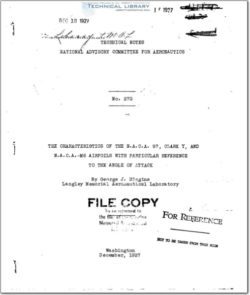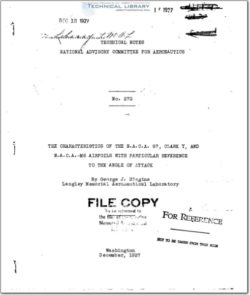naca-tn-270

- Version
- 314 Downloads
- 791.44 KB File Size
- 1 File Count
- April 23, 2016 Create Date
- April 23, 2016 Last Updated
National Advisory Committee for Aeronautics, Technical Notes - The Characteristics of the NACA 97, Clark Y and NACA M6 Airfoils with Particular Reference to the Angle of Attack

This note gives the aerodynamic characteristics of the
N.A.C.A. 97, Clark Y, and N.A.C.A.—M8 airfoil sections as de—
termined in the variable density wind tunnel at_Langley Field,
Virginia. Particular attention is called to the relation of
the characteristics to the angle of attack in their use in
airplane design.
In the adaptation of a certain airfoil section.to an air—
plane design, it is necessary to make a careful study of the
airfoil characteristics in order that the best performance may
be attained on the completed airplane. Speed range and pay
load are the important factors which are dependent directly on
a careful selection and use of the wing section. The angle of
wing setting or incidence on an airplane should be known in
terms of the absolute angle of attack.
The angle between any reference line On an airfoil sec—
tion at any time and that line when the direction of motion is
such that the lift is zero, is called the absolute angle of
attack (see Figure 1). It is this angle that is used in theo—
retical fermulas for determining airfoil characteristics. One
finds from experimental tests that the lift of an airfoil is
directly proportional to the absolute angle of attack, being
approximately the same for all sections. The minimum drag
coefficient occurs at about zero lift or at about zero absolute
angle of attack. The value of the minimum drag is, however,
dependent on the choice of the section. Likewise, the maximum
lift is determined by the burbling characteristics of the in—
dividual airfoil.
The ordinary or geometric angle of attack measured from
the chord line is, with nost_airfoils, different from the abso—
lute angle of attack. For checking rigging and angle of inci—
dence it is most convenient to use the geometric angle as it
can readily be measured. The designer, however, should be care—
ful that he does not confuse the two, particularly if employing
empirical formulas.
| File | Action |
|---|---|
| naca-tn-270 The Characteristics of the NACA 97, Clark Y and NACA M6 Airfoils with Particular Reference to the Angle of Attack.pdf | Download |
Comment On This Post